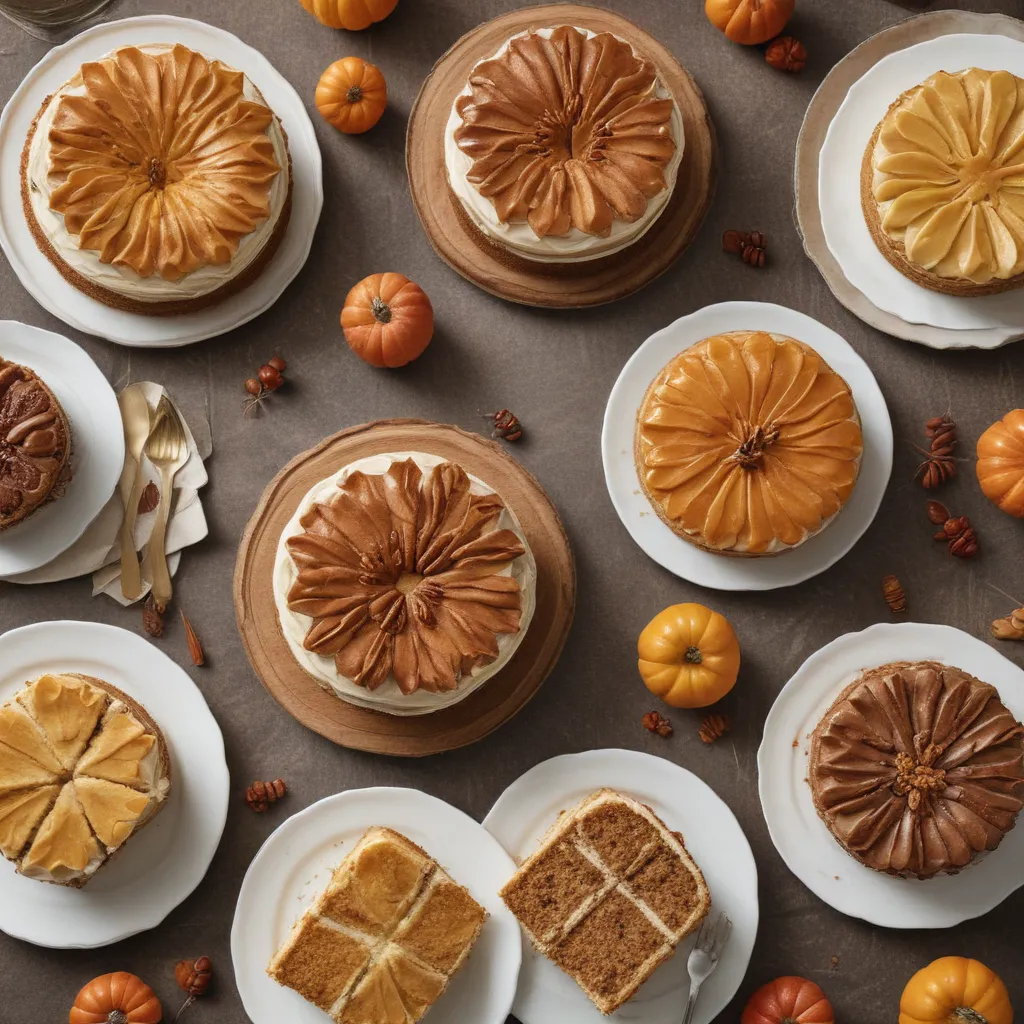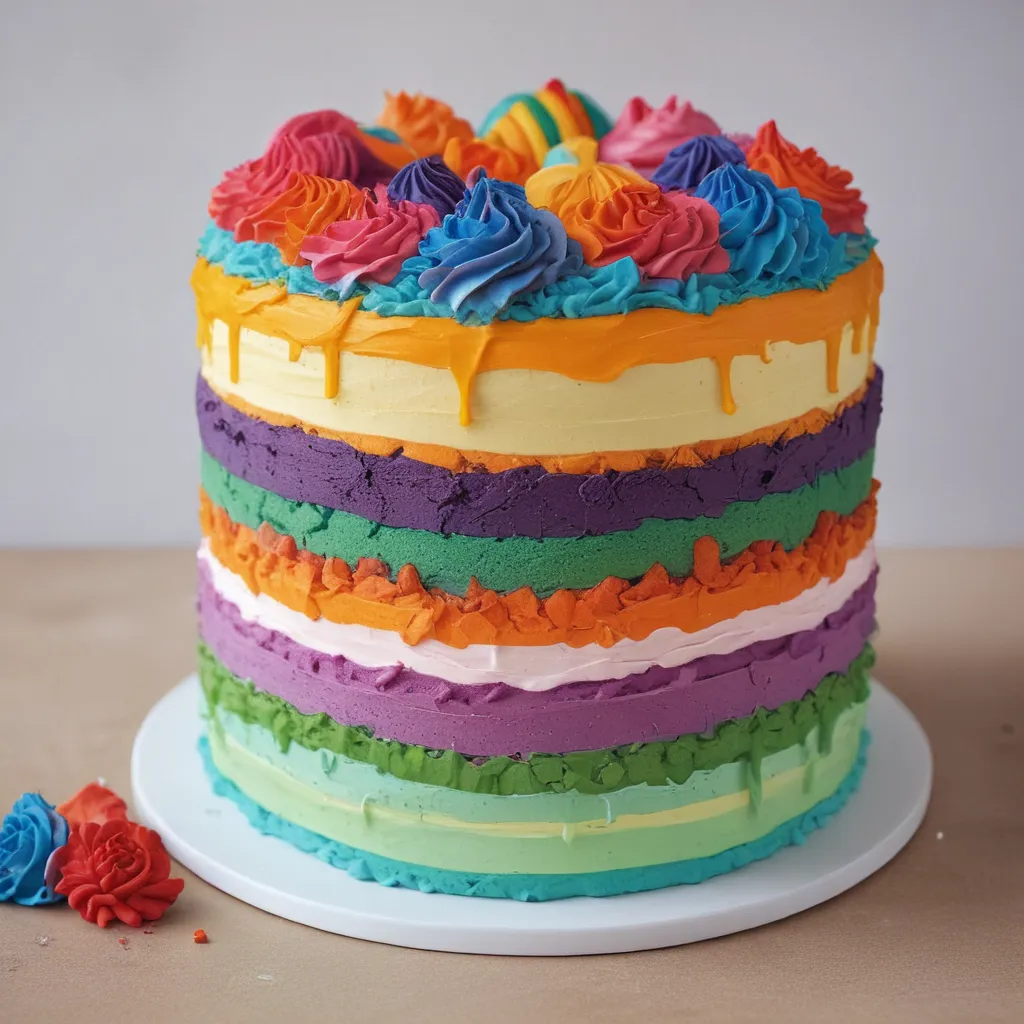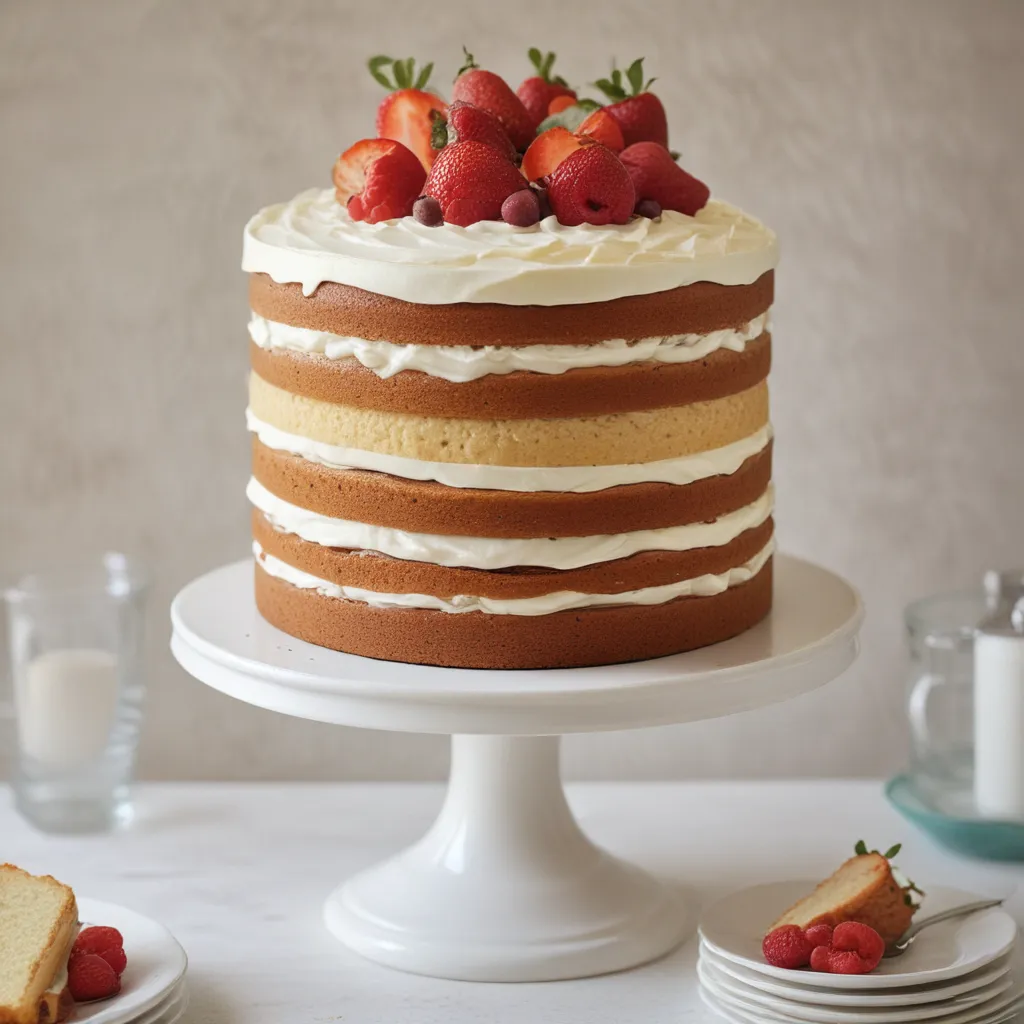Ah, the joys of baking – the soothing scents of freshly-baked goods, the satisfaction of a beautifully-crafted confection, and the smiles you bring to people’s faces. But let’s be real, it’s not always a piece of cake (pun intended!). As a seasoned cake artist at Jax Cake Shop in San Jose, I’ve seen my fair share of baking blunders and have learned a thing or two about troubleshooting these tricky situations.
Cracking the Code on Cake Cracks
One of the most common issues I encounter is the dreaded cake crack. You spend hours meticulously mixing, pouring, and baking, only to end up with a pastry that looks like the San Andreas Fault. What gives? Well, my friends, it’s often a matter of temperature control, and I’m here to share my secrets.
The key to preventing those unsightly cracks is to maintain a consistent oven temperature throughout the baking process. Sudden temperature fluctuations can cause the cake to expand and contract, leading to those pesky fissures. I always recommend preheating your oven thoroughly and keeping a close eye on the temperature. And if you’re using a convection oven, be sure to adjust the temperature accordingly, as the air circulation can cause the outer edges to bake faster than the center.
Another culprit could be over-mixing the batter. When you incorporate too much air into the mixture, the cake is more prone to rising rapidly and then collapsing, creating those unsightly cracks. I like to use a gentle folding motion when combining my ingredients, and I always resist the urge to overmix.
But what if you’ve already got a cracked cake on your hands? Fear not, my baking buddies! A simple trick is to use a serrated knife to carefully level the top of the cake, removing any uneven or protruding edges. Then, you can use a delicious buttercream or ganache to “glue” the cake back together, effectively hiding those pesky cracks.
Vanquishing the Dreaded Dry Cake
Ah, the dry cake – the bane of every baker’s existence. You know the one, where every bite feels like you’re chewing on a stale sponge. It’s enough to make you want to toss the whole thing in the trash and start over. But fear not, I’ve got your back.
One of the primary culprits of a dry cake is over-baking. I know it can be tempting to keep that timer ticking, but trust me, a few extra minutes can make all the difference. I always recommend checking your cake a few minutes before the recommended baking time and then adjusting accordingly. And don’t forget to use a toothpick or cake tester to ensure the center is cooked through without going overboard.
Another factor to consider is the quality of your ingredients. Using fresh, high-quality flour, eggs, and dairy products can make a world of difference in the moistness and texture of your cake. I always make sure to check the expiration dates on my baking essentials and store them properly to maintain their freshness.
But what if you’ve already ended up with a dry cake? No need to panic, my friends! A simple solution is to use a simple syrup or fruit-based glaze to infuse moisture back into the cake. Just brush or drizzle the liquid over the top, and let it soak in for a few minutes before frosting. You can even get creative and experiment with different flavors, like lemon or raspberry, to give your cake a delightful zing.
Conquering the Crumbly Catastrophe
Ah, the crumbly cake – the nemesis of every cake artist. You’ve followed the recipe to a T, your baking technique is on point, but somehow, your cake disintegrates like a house of cards when you try to frost it. What’s a baker to do?
Well, let me tell you, my friends, the secret to a sturdy, crumb-free cake lies in the ratio of your ingredients. Too much flour or not enough fat can lead to a dry, crumbly texture that just won’t hold together. I always recommend using a kitchen scale to precisely measure your dry and wet ingredients, ensuring the perfect balance.
Another sneaky culprit could be over-mixing the batter. When you incorporate too much air into the mixture, the gluten strands in the flour can become overstretched, resulting in a fragile, crumbly cake. I like to use a gentle folding motion when combining my ingredients, and I always resist the urge to overmix.
But what if you’ve already got a crumbly cake on your hands? Don’t worry, I’ve got a trick or two up my sleeve. One of my favorite methods is to use a cake leveler or serrated knife to carefully trim off the domed top of the cake, creating a flat, even surface. Then, I’ll brush the top with a simple syrup or fruit-based glaze, which helps to bind the crumbs and create a sturdy foundation for frosting.
And if that doesn’t do the trick, I’ve got another secret weapon: a crumb coat. This thin layer of frosting acts as a barrier, sealing in the crumbs and providing a smooth, even surface for the final layer of frosting. It’s a game-changer, I tell you!
Battling the Dreaded Dry Buttercream
You’ve meticulously whipped up a batch of silky-smooth buttercream, only to find that it’s as dry and stiff as a board. What’s a cake artist to do? Fear not, my friends, I’ve got the solutions to your buttercream woes.
One of the most common culprits of dry buttercream is over-whipping. When you beat the mixture for too long, the fat and air molecules can become overworked, resulting in a dry, stiff consistency. I always recommend starting on a lower speed and gradually increasing the mixing time, keeping a close eye on the texture.
Another factor to consider is the temperature of your ingredients. Buttercream is sensitive to temperature changes, and using cold butter or milk can cause the mixture to seize up and become dry. I like to let my butter come to room temperature before starting, and I’ll sometimes warm the milk or cream slightly to ensure a smooth, creamy consistency.
But what if you’ve already ended up with a dry, stiff buttercream? Fear not, my friends, I’ve got a trick or two up my sleeve. One of my favorite methods is to add a tablespoon or two of heavy cream or milk to the mixture, slowly incorporating it until the buttercream regains its silky, spreadable texture. You can also try adding a tiny pinch of salt, which can help to balance the flavors and enhance the overall creaminess.
And if that doesn’t do the trick, I’ve got another secret weapon: a bit of melted chocolate or a splash of liqueur. These flavorful additions can not only add depth and complexity to your buttercream, but they can also help to soften the texture and make it more pliable.
Mastering the Art of Even Baking
Ah, the elusive even bake – the holy grail of baking. You’ve followed the recipe to a T, your oven is calibrated and ready to go, but somehow, your cakes always come out lopsided or with uneven layers. What’s a cake artist to do?
Well, my friends, the secret to an even bake lies in the positioning and rotation of your pans. I always make sure to place my cake pans on the middle rack of the oven, ensuring they’re equidistant from the top and bottom heating elements. And don’t forget to rotate the pans halfway through the baking time – this helps to ensure even heat distribution and prevents those dreaded hot spots.
Another factor to consider is the type of pan you’re using. Lighter-colored, non-stick pans can help to prevent over-browning on the edges, while darker pans may cause the outside to cook faster than the center. I like to keep a variety of pans on hand and experiment to find the ones that work best for my specific oven and recipes.
But what if you’ve already ended up with an uneven cake? Don’t worry, my friends, I’ve got a few tricks up my sleeve. One of my favorite methods is to use a serrated knife to carefully level the top of the cake, removing any uneven or protruding edges. This not only creates a smooth, even surface for frosting, but it also helps to balance out the overall height of the layers.
And if that doesn’t do the trick, I’ve got another secret weapon: a cake leveler. This nifty little tool allows me to slice my cakes into perfectly even layers, ensuring a flawless final product every time. It’s a game-changer, I tell you!
Overcoming the Obstacle of Overbaked Edges
Ah, the dreaded overbaked edges – the bane of every cake artist’s existence. You’ve followed the recipe to a T, your oven is calibrated and ready to go, but somehow, the edges of your cakes always come out dry and tough, while the centers remain moist and delicious. What’s a baker to do?
Well, my friends, the secret to preventing overbaked edges lies in the type of pan you’re using and the placement of your cakes in the oven. I always make sure to use lightweight, light-colored pans, as these tend to distribute heat more evenly and prevent the edges from overcooking. And when it comes to oven placement, I like to position my cakes on the middle rack, ensuring they’re equidistant from the top and bottom heating elements.
Another trick I’ve learned is to use baking strips or cake strips. These nifty little accessories wrap around the outside of your cake pans, insulating the edges and preventing them from baking too quickly. It’s a game-changer, I tell you!
But what if you’ve already ended up with overbaked edges? Don’t worry, my friends, I’ve got a few tricks up my sleeve. One of my favorite methods is to use a serrated knife to carefully trim off the tough, dry edges, creating a nice, even surface for frosting. And if that doesn’t do the trick, I’ve got another secret weapon: a simple syrup or fruit-based glaze.
By brushing or drizzling a bit of this liquid goodness over the top of the cake, you can infuse moisture back into those dry, overbaked edges, effectively turning them into a moist, flavorful base for your delicious frosting. It’s a win-win, if you ask me!
Conquering the Stubborn Sticking Situation
Ah, the dreaded stuck-on cake – the bane of every baker’s existence. You’ve greased and floured your pans to the nines, but somehow, your cakes still refuse to release from their metal prisons. What’s a cake artist to do?
Well, my friends, the secret to preventing stuck-on cakes lies in the type of pan you’re using and the way you prepare it. I always make sure to use high-quality, non-stick pans, and I coat them generously with a layer of butter or non-stick cooking spray. And don’t forget to dust the pans with a light coating of flour, which helps to create a barrier between the cake and the pan.
Another trick I’ve learned is to let the cakes cool completely before attempting to remove them from the pans. When the cakes are still warm, the delicate crumb can be more prone to sticking, so I like to wait at least 15-20 minutes before gently inverting them onto a cooling rack.
But what if you’ve already ended up with a stubborn, stuck-on cake? Don’t worry, my friends, I’ve got a few tricks up my sleeve. One of my favorite methods is to use a knife or offset spatula to gently loosen the edges of the cake, working my way around the pan until the whole thing releases. And if that doesn’t do the trick, I’ve got another secret weapon: a steaming hot towel.
By placing a hot, damp towel over the top of the pan for a few minutes, the steam can help to release the cake, making it much easier to remove. It’s a game-changer, I tell you!
Mastering the Art of Smooth Frosting
Ah, the silky-smooth frosting – the crowning glory of any cake. You’ve whipped up a batch of buttercream that’s as light and fluffy as a cloud, but somehow, when it comes time to frost your cake, it’s a lumpy, bumpy mess. What’s a cake artist to do?
Well, my friends, the secret to achieving a smooth, professional-looking frosting lies in the way you apply it. I always start with a crumb coat, a thin layer of frosting that seals in any pesky crumbs and creates a smooth foundation for the final layer. And when it comes to that final coat, I like to use a combination of offset spatulas and turntables to create a seamless, flawless finish.
Another trick I’ve learned is to keep my frosting at the perfect consistency. If it’s too thick, it can be difficult to spread and may end up looking lumpy and uneven. But if it’s too thin, it can be a real challenge to achieve that perfect, smooth texture. I like to keep a bowl of powdered sugar and a bit of heavy cream on hand, adjusting the consistency as needed until it’s just right.
But what if you’ve already ended up with a bumpy, lumpy frosting? Don’t worry, my friends, I’ve got a few tricks up my sleeve. One of my favorite methods is to use a warm, damp spatula to gently smooth out any bumps or ridges, working in small sections until the entire surface is perfectly even.
And if that doesn’t do the trick, I’ve got another secret weapon: a frosting comb. This nifty little tool allows me to create a perfectly smooth, even finish on my cakes, with just a few gentle swipes. It’s a game-changer, I tell you!
Conclusion: A Cake Artist’s Final Thoughts
Well, there you have it, folks – my tried-and-true tips and tricks for conquering the most common baking issues. From cracked cakes and dry buttercream to stubborn sticking situations, I’ve faced them all in my time as a cake artist, and I’m here to share what I’ve learned.
But you know, baking isn’t just about avoiding disasters – it’s about the journey, the creative process, and the joy of sharing your creations with others. And let me tell you, there’s nothing quite like the look of delight on a client’s face when they take that first bite of a perfectly-baked, beautifully-decorated cake.
So don’t let those pesky baking challenges get you down, my friends. Embrace the adventure, experiment with new techniques, and remember to have fun along the way. After all, that’s what being a cake artist is all about. And if you’re ever in need of a little extra guidance or inspiration, be sure to check out Jax Cake Shop in San Jose – we’re always here to lend a helping hand (or a spatula!).





